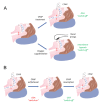Experimental Models to Study End-Organ Morbidity in Sleep Apnea: Lessons Learned and Future Directions
- PMID: 36430904
- PMCID: PMC9696027
- DOI: 10.3390/ijms232214430
Experimental Models to Study End-Organ Morbidity in Sleep Apnea: Lessons Learned and Future Directions
Abstract
Sleep apnea (SA) is a very prevalent sleep breathing disorder mainly characterized by intermittent hypoxemia and sleep fragmentation, with ensuing systemic inflammation, oxidative stress, and immune deregulation. These perturbations promote the risk of end-organ morbidity, such that SA patients are at increased risk of cardiovascular, neurocognitive, metabolic and malignant disorders. Investigating the potential mechanisms underlying SA-induced end-organ dysfunction requires the use of comprehensive experimental models at the cell, animal and human levels. This review is primarily focused on the experimental models employed to date in the study of the consequences of SA and tackles 3 different approaches. First, cell culture systems whereby controlled patterns of intermittent hypoxia cycling fast enough to mimic the rates of episodic hypoxemia experienced by patients with SA. Second, animal models consisting of implementing realistic upper airway obstruction patterns, intermittent hypoxia, or sleep fragmentation such as to reproduce the noxious events characterizing SA. Finally, human SA models, which consist either in subjecting healthy volunteers to intermittent hypoxia or sleep fragmentation, or alternatively applying oxygen supplementation or temporary nasal pressure therapy withdrawal to SA patients. The advantages, limitations, and potential improvements of these models along with some of their pertinent findings are reviewed.
Keywords: CPAP withdrawal; airway obstruction; animal model; cell model; human model; intermittent hypoxia; oxygen supplementation; sleep apnea pathophysiology; sleep fragmentation.
Conflict of interest statement
The authors declare no conflict of interest.
Figures





Similar articles
-
Sleep Apnea: Types, Mechanisms, and Clinical Cardiovascular Consequences.J Am Coll Cardiol. 2017 Feb 21;69(7):841-858. doi: 10.1016/j.jacc.2016.11.069. J Am Coll Cardiol. 2017. PMID: 28209226 Free PMC article. Review.
-
Periodic limb movements in sleep revealed by treatment of sleep apnea with continuous positive airway pressure in the advanced chronic kidney disease population.Clin Nephrol. 2011 Dec;76(6):470-4. doi: 10.5414/cn107072. Clin Nephrol. 2011. PMID: 22105450
-
Cardiovascular consequences of sleep-disordered breathing: contribution of animal models to understanding the human disease.ILAR J. 2009;50(3):262-81. doi: 10.1093/ilar.50.3.262. ILAR J. 2009. PMID: 19506313 Review.
-
Treatment of sleep apnea in heart failure.Am J Respir Crit Care Med. 2006 Jun 15;173(12):1300-8. doi: 10.1164/rccm.200511-1745PP. Epub 2006 Mar 9. Am J Respir Crit Care Med. 2006. PMID: 16528015 Review.
-
Biological plausibility linking sleep apnoea and metabolic dysfunction.Nat Rev Endocrinol. 2016 May;12(5):290-8. doi: 10.1038/nrendo.2016.22. Epub 2016 Mar 4. Nat Rev Endocrinol. 2016. PMID: 26939978 Review.
Cited by
-
Microglia and Sleep Disorders.Adv Neurobiol. 2024;37:357-377. doi: 10.1007/978-3-031-55529-9_20. Adv Neurobiol. 2024. PMID: 39207702 Review.
-
Cardiovascular Disease in Obstructive Sleep Apnea: Putative Contributions of Mineralocorticoid Receptors.Int J Mol Sci. 2023 Jan 23;24(3):2245. doi: 10.3390/ijms24032245. Int J Mol Sci. 2023. PMID: 36768567 Free PMC article. Review.
-
The Effects of Volatile Anesthetics on Renal Sympathetic and Phrenic Nerve Activity during Acute Intermittent Hypoxia in Rats.Biomedicines. 2024 Apr 19;12(4):910. doi: 10.3390/biomedicines12040910. Biomedicines. 2024. PMID: 38672264 Free PMC article.
-
Low-cost, open-source device for simultaneously subjecting rodents to different circadian cycles of light, food, and temperature.Front Physiol. 2024 Feb 16;15:1356787. doi: 10.3389/fphys.2024.1356787. eCollection 2024. Front Physiol. 2024. PMID: 38434139 Free PMC article.
-
Cardiac Sympathetic Denervation Mitigated Ischemic Cardiomyopathy Progression in a Rat Model of Sleep Apnea.J Am Heart Assoc. 2025 Jun 3;14(11):e038781. doi: 10.1161/JAHA.124.038781. Epub 2025 May 23. J Am Heart Assoc. 2025. PMID: 40407052 Free PMC article.
References
-
- Benjafield A.V., Ayas N.T., Eastwood P.R., Heinzer R., Ip M.S.M., Morrell M.J., Nunez C.M., Patel S.R., Penzel T., Pépin J.L.D., et al. Estimation of the global prevalence and burden of obstructive sleep apnoea: A literature-based analysis. Lancet Respir. Med. 2019;7:687–698. doi: 10.1016/S2213-2600(19)30198-5. - DOI - PMC - PubMed
-
- Chiu H.-Y., Chen P.-Y., Chuang L.-P., Chen N.-H., Tu Y.-K., Hsieh Y.-J., Wang Y.-C., Guilleminault C. Diagnostic accuracy of the Berlin questionnaire, STOP-BANG, STOP, and Epworth sleepiness scale in detecting obstructive sleep apnea: A bivariate meta-analysis. Sleep Med. Rev. 2017;36:57–70. doi: 10.1016/j.smrv.2016.10.004. - DOI - PubMed
-
- Bonsignore M.R., Randerath W., Schiza S., Verbraecken J., Elliott M.W., Riha R., Barbe F., Bouloukaki I., Castrogiovanni A., Deleanu O., et al. European Respiratory Society statement on sleep apnoea, sleepiness and driving risk. Eur. Respir. J. 2021;57:2001272. doi: 10.1183/13993003.01272-2020. - DOI - PubMed

